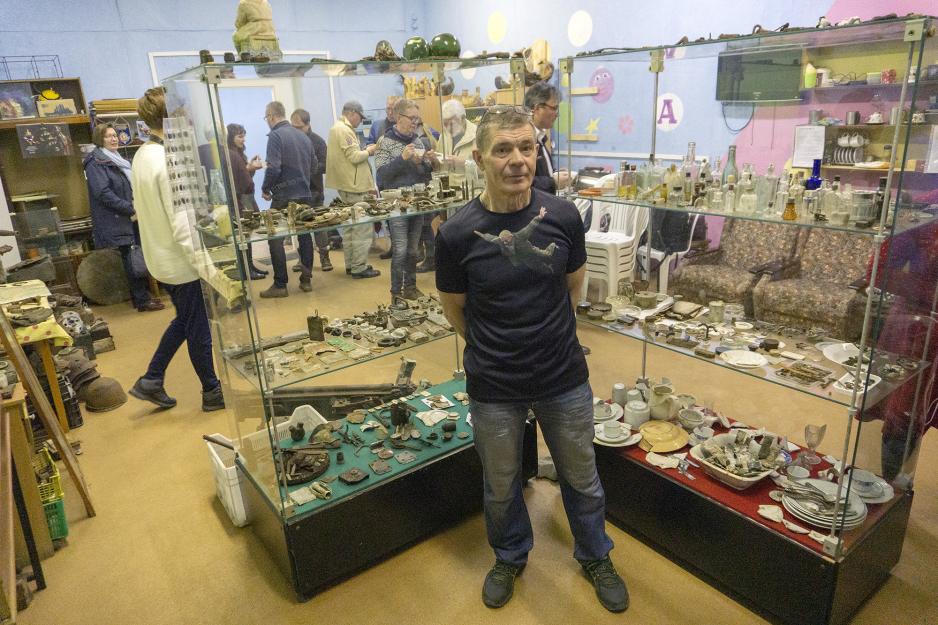The War That Never Ends

Every family in Russia has lost relatives in this war. That is why the war is so important to Russians, says Aleksandr Feduhin. Photo: Amund Trellevik
Eight of his relatives were sent to the frontline and disappeared. 75 years after the end of WW2, volunteers like Aleksandr Feduhin (61) still work on digging out fallen soldiers from the bloody battles at the Litsa front.
NIKEL, RUSSIA: - He who forgets his past does not have a future, says Aleksandr Feduhin while showing us around the exhibition in the northern Russian border town Nikel.
Feduhin, a 61-year old welder, spends all his free time documenting the misery and tragedy of WW2. Every summer, he goes on a six-week field trip to the Litsa front to dig out fallen soldiers. Over the past few years he has personally found 70 persons fallen in battle, but who never received a burial until now.
- We make the coffins ourselves and bury the people in an area near where the frontline was, Feduhin explains.
The battle at the Litsa front
The Litsa Front refers to the acts of war and the frontline between Germany and the Soviet Union in northern Finland and northwestern Russia during WW2. The Litsa Front is also known as the Murmansk Front and the North Front. It was a part of the overall “Operation Silverfox” that was led by Eduard Dietl – known to the Germans as “the hero from Narvik”.
Germany had forces in the area following its occupying Norway during Operation Weserübing. The Germans wanted to prevent the Soviet Union from using the deep water port in Murmansk to receive supplies from the West, in particular the USA.
The main attack against the strategically important bridge across the Litsa river started on 5 July 1941. The river formed a natural defense line for the Soviet forces. The Germans managed to establish minor posts on the east side of the river, however, the Soviet forces struck back each time and there were major losses on both sides.
From mid-September 1941 and onwards, it transitioned into a standstill war. The Germans prioritized keeping forces in the area to secure the nickel mines in the Petsamo region as well as to bind up Soviet forces on the Soviet side.
The Germans only withdrew their troops following Finland’s signing an armistice agreement with the Soviet Union on 4/5 October 1944. This lead to Germany withdrawing its forces from Finland and in Norway, they withdrew all the way down to Lyngen in Troms county. They applied the scorched-earth tactics in all areas from which they retreated.
Source: Wikipedia
The frontline froze
An estimated 50,000 people fell on both sides of the Litsa front during WW2. After Germany had declared war against the Soviet Union on 22 June 1941, German forces eventually attacked in the high north too. Their goal was Murmansk, a strategically important city with an ice-free port.
On 5 July the attack against the strategically important bridge across the Litsa river between Murmansk and Kirkenes commenced. The river formed a natural defense line for the Soviet forces. The Germans managed to establish minor posts on the east side of the river, however, the Soviets fought back each time and there were great losses on both sides.
In September that year, the frontline froze and the fights turned into a standstill war. Bitter fighting about a bunker facility took place along the northern axis towards the peninsula. This is the area in which Feduhin focuses his search.
- The assignment for the Soviet soldiers was to destroy this battery. They managed to do so in the end, though the price they paid was very high. We have found 70 dead soldiers up until today, Feduhin says while showing us the various defense positions on an old map.
- This is height 122. This is height 109. Some of the worst fights took place here. For four years the stood here watching each other. They could throw grenades back and forth.
Were never meant to stay through winter
Norway and Russia are this week commemorating the fact that it is 75 years ago since troops from the Red Army liberated East Finnmark from the German occupation. On 25 October, the Norwegian flag was hoisted for the very first time in the freed Norway following Soviet forces’ arriving in Kirkenes and Bjørnevatn.
Soviet forces reached Rustefjelbma in Tana on 8 November and stopped their advance there. The forces withdrew from Norway the following year.
Norway’s King Harald will be present in Kirkenes on Friday, along with Prime Minister Erna Solberg and Foreign Minister Ine Eriksen Søreide. Russian Foreign Minister Sergey Lavrov attends from the Russian side. In addition to the commemoration event itself, there will also be a bilateral meeting between Søreide and Lavrov.
In the exhibition room, everything from perfume to German Deutshemark coins and delousing agents is on display. Feduhin shows us the difference between a German and at Soviet plate on the various jacket buttons that were used.
Even though Feduhin mainly looks for fallen soldiers on the Soviet side of the frontline, he finds German soldiers too. By studying the differences on the equipment for a Soviet and a German soldier, one can clearly see that the German forces were well prepared for the attack, Feduhin says.
Though there are some exceptions:
- The Soviet soldiers were better prepared for the winter war. German forces had not thought they would be overwintering.
- Why do you put so much personal time and engagement into this work?
- Eight of my father’s relatives were sent to the frontline and disappeared. But that is not the only reason. There are very few people who do this kind of work. Without remembering our history we do not hold a future. Every single family in Russia has lost some of their relatives in this war. That is why the war is so important to Russians, says Feduhin.

